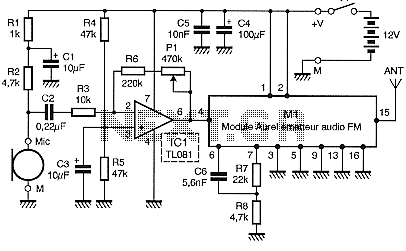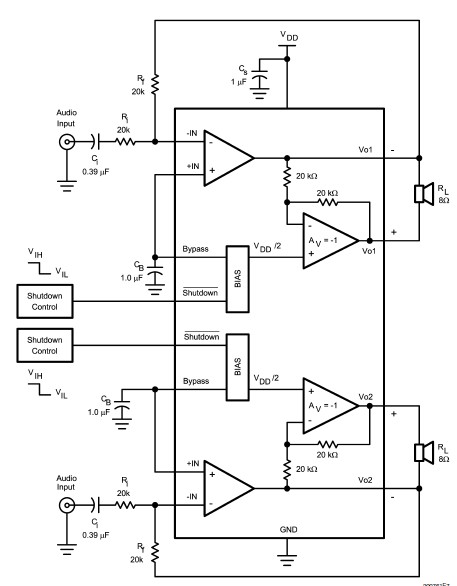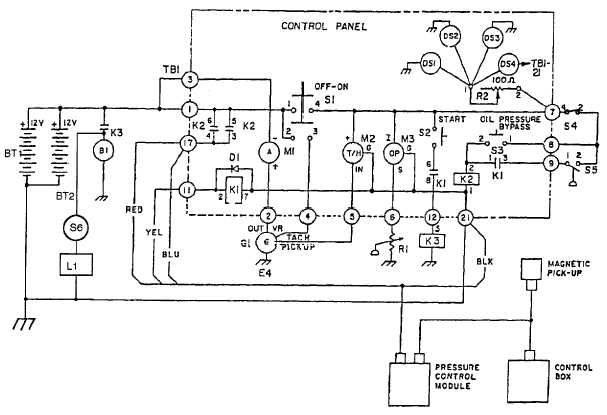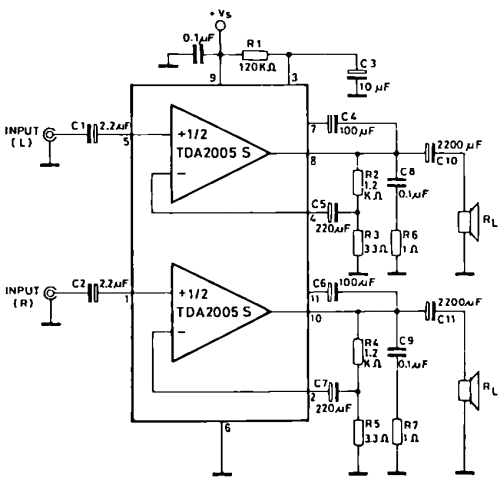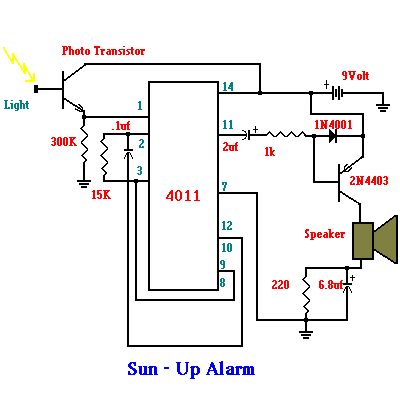
Schematic of the endoelectronics Biotechnology
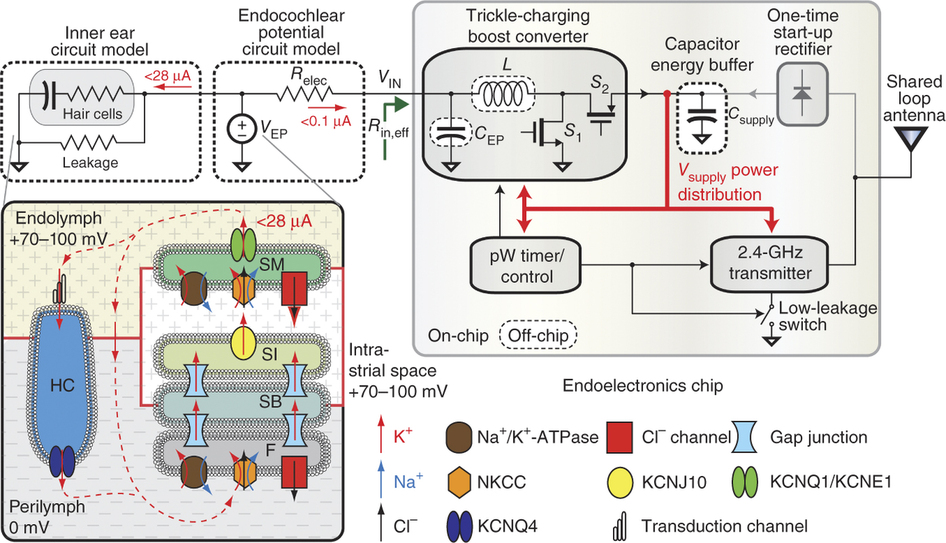
To generate and maintain the endocochlear potential (EP), perilymphatic potassium ions (K+) enter fibrocytes (F) through the Na+/K+-ATPase and Na-K-Cl cotransporter. Gap junction networks connect fibrocytes to strial basal (SB) and intermediate (SI) cells, allowing ions to enter the intrastrial space via KCNJ10 channels. Strial marginal (SM) cells uptake K+ against a significant concentration gradient and release K+ into the endolymph. Potassium ions return to perilymph either by entering hair cells (HC) apically during mechanoelectrical transduction of sound and exiting basolaterally through KCNQ4 channels, or through leakage current across the surrounding tissues (solid red lines represent tight-junction networks). Utilizing the energy from the EP, a boost converter trickle-charges capacitor Csupply, which powers an integrated wireless transmitter. Switch S1 in the converter temporarily stores energy in the inductor (L), while switch S2 transfers the stored energy to Csupply at the required higher voltage. Once Csupply has accumulated enough energy, the transmitter activates and wirelessly transmits a packet to a nearby receiver, subsequently reverting to a low-leakage standby mode while the boost converter replenishes Csupply. A start-up rectifier is employed with an external wireless power source to initialize the system.
The electronic circuit described involves multiple components and processes for efficient energy management and signal transmission. The Na+/K+-ATPase and Na-K-Cl cotransporter are critical for maintaining the ionic balance necessary for the generation of the endocochlear potential, enabling the proper functioning of auditory processing. The integration of gap junctions facilitates rapid ion exchange between fibrocytes and strial cells, which is essential for maintaining the ionic environment within the cochlea.
The boost converter circuit is pivotal in this system, comprising an inductor (L), two switches (S1 and S2), and a capacitor (Csupply). Switch S1 is responsible for storing energy in the inductor during the charging phase, while switch S2 is activated to transfer this energy to the capacitor at a higher voltage, ensuring that the wireless transmitter has sufficient power to operate. The operational efficiency of this circuit is enhanced by the use of a start-up rectifier, which allows for initial system activation using an external wireless power source, thus ensuring reliable performance.
The wireless transmitter, once charged, engages in data transmission, sending packets to a receiver, which is crucial for applications in auditory research and hearing technology. The transition to a low-leakage standby mode after transmission reflects an energy-efficient design, allowing the system to conserve power while awaiting the next transmission cycle. Overall, this circuit exemplifies a sophisticated integration of biological principles and electronic engineering to facilitate advancements in hearing science.To generate and maintain the EP, perilymphatic K+ enters fibrocytes (F) via Na+/K+-ATPase and Na-K-Cl cotransporter. Gap junction networks connect fibrocytes to strial basal (SB) and intermediate (SI) cells, allowing ions to enter the intrastrial space via KCNJ10 channels.
Strial marginal (SM) cells uptake K+ against a substantial concentration gradient and release K+ into endolymph. K+ returns to perilymph either by entering hair cells (HC) apically during mechanoelectrical transduction of sound and exiting basolaterally via KCNQ4 channels, or via leakage current through the surrounding tissues (solid red lines represent tight-junction networks). With energy from the EP, a boost converter was used to trickle-charge capacitor Csupply, which supplies power to an integrated wireless transmitter.
Switch S1 in the converter was used to temporarily store energy in the inductor (L), and switch S2 was used to transfer the stored energy onto Csupply at the higher required voltage. Once Csupply had stored sufficient energy, the transmitter entered its active mode and wirelessly transmitted a packet to a nearby receiver, after which it returned to a low-leakage standby mode and the boost converter began to replenish Csupply.
A start-up rectifier was used with an external wireless power source to initialize the system. Program in Speech and Hearing Bioscience and Technology, Harvard/Massachusetts Institute of Technology Joint Division of Health Sciences and Technology, Cambridge, Massachusetts, USA. A. P. C. and K. M. S. conceived the project. P. P. M. , A. C. L. , S. B. , A. P. C. and K. M. S. designed experiments. P. P. M. , A. C. L. and S. B. performed the experiments. P. P. M. and S. B. designed and implemented the electronic chip. A. C. L. performed the EP measurements. 🔗 External reference
The electronic circuit described involves multiple components and processes for efficient energy management and signal transmission. The Na+/K+-ATPase and Na-K-Cl cotransporter are critical for maintaining the ionic balance necessary for the generation of the endocochlear potential, enabling the proper functioning of auditory processing. The integration of gap junctions facilitates rapid ion exchange between fibrocytes and strial cells, which is essential for maintaining the ionic environment within the cochlea.
The boost converter circuit is pivotal in this system, comprising an inductor (L), two switches (S1 and S2), and a capacitor (Csupply). Switch S1 is responsible for storing energy in the inductor during the charging phase, while switch S2 is activated to transfer this energy to the capacitor at a higher voltage, ensuring that the wireless transmitter has sufficient power to operate. The operational efficiency of this circuit is enhanced by the use of a start-up rectifier, which allows for initial system activation using an external wireless power source, thus ensuring reliable performance.
The wireless transmitter, once charged, engages in data transmission, sending packets to a receiver, which is crucial for applications in auditory research and hearing technology. The transition to a low-leakage standby mode after transmission reflects an energy-efficient design, allowing the system to conserve power while awaiting the next transmission cycle. Overall, this circuit exemplifies a sophisticated integration of biological principles and electronic engineering to facilitate advancements in hearing science.To generate and maintain the EP, perilymphatic K+ enters fibrocytes (F) via Na+/K+-ATPase and Na-K-Cl cotransporter. Gap junction networks connect fibrocytes to strial basal (SB) and intermediate (SI) cells, allowing ions to enter the intrastrial space via KCNJ10 channels.
Strial marginal (SM) cells uptake K+ against a substantial concentration gradient and release K+ into endolymph. K+ returns to perilymph either by entering hair cells (HC) apically during mechanoelectrical transduction of sound and exiting basolaterally via KCNQ4 channels, or via leakage current through the surrounding tissues (solid red lines represent tight-junction networks). With energy from the EP, a boost converter was used to trickle-charge capacitor Csupply, which supplies power to an integrated wireless transmitter.
Switch S1 in the converter was used to temporarily store energy in the inductor (L), and switch S2 was used to transfer the stored energy onto Csupply at the higher required voltage. Once Csupply had stored sufficient energy, the transmitter entered its active mode and wirelessly transmitted a packet to a nearby receiver, after which it returned to a low-leakage standby mode and the boost converter began to replenish Csupply.
A start-up rectifier was used with an external wireless power source to initialize the system. Program in Speech and Hearing Bioscience and Technology, Harvard/Massachusetts Institute of Technology Joint Division of Health Sciences and Technology, Cambridge, Massachusetts, USA. A. P. C. and K. M. S. conceived the project. P. P. M. , A. C. L. , S. B. , A. P. C. and K. M. S. designed experiments. P. P. M. , A. C. L. and S. B. performed the experiments. P. P. M. and S. B. designed and implemented the electronic chip. A. C. L. performed the EP measurements. 🔗 External reference
